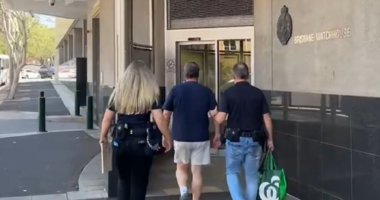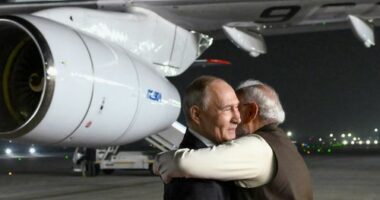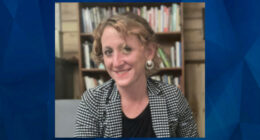Share this @internewscast.com
Ashley Brooks-Garrett never really considered Botox until she got engaged and her social media algorithm changed.
Out of the blue, her social media platforms like TikTok and Instagram were flooded with images of flawless brides and discussions about cosmetic enhancements ranging from budget-friendly skincare treatments to high-end Botox and fillers.
Cosmetic enhancements, particularly nonsurgical options, are increasingly becoming a staple in wedding prep routines. The US aesthetics firm RealSelf noted a 30 percent spike in reviews related to wedding-focused cosmetic procedures just in 2019.

Wedding planning sites offer “beauty timelines” that advise brides on the ideal times for undergoing particular procedures. Besides, cosmetic clinics are pushing bridal packages, and social media is teeming with soon-to-be brides showcasing their transformation in before-and-after photos.
The result is an intense pressure to join in, one that almost cost Brooks-Garrett $1700.
“Being bombarded with images of perfect brides constantly on social media definitely played a part in the pressure I felt to look a certain way,” she told 9news.com.au.
“Society expects you to be absolutely perfect for one whole day and it’s absolutely impossible … it left me in a huge state of panic.”
So she traded her Aldi cleanser for a $250 skincare routine, spent $900 on facials and booked $600 worth of Botox.
Clinical psychologist and co-founder of ReadyMind Cosmetic Psychology Dr Toni Pikoos said Brooks-Garrett isn’t the first bride to be sucked in by social media pressure to look perfect and she won’t be the last.
These days, influencers and everyday women publicise their cosmetic procedures on social media, normalising what used to be a taboo experience.
While that’s not necessarily a bad thing, it can have a huge impact on brides.
“The narrative around cosmetic procedures in society is really shifting towards this view of them being part of self-care and empowerment,” Pikoos said.
“When you’re bombarded with that sort of messaging, you start to feel like, ‘That’s what I’m supposed to be doing for the big day as well.'”
Specialist medical practitioner Dr Imaan Joshi said pressure may prompt brides to undergo procedures they don’t need or may regret.
“I do think that it’s a little bit predatory, for lack of a better word, to start suggesting all these things to young women who don’t actually need anything,” she said.
“But social media presents it as just another thing you do on your path to getting married.”
Brooks-Garrett admits she almost fell into that trap but ended up cancelling her $600 Botox less than 24 hours beforehand.
“I panicked,” she said, adding that she wanted to “look like herself” in wedding photos.

She also “couldn’t justify the expense” on top of all her other wedding costs but some Australian brides get around that by travelling overseas for cheaper cosmetic procedures in a practice known as medical tourism.
David Allen, chief executive of medical tourism operator Asthetica, said business is booming in Australia and brides-to-be are interested in travelling to Turkey for eyebrow transplants, dental veneers and teeth whitening on a budget.
Some have also inquired about more invasive procedures, including liposuction, abdominoplasty (tummy tuck), gastric sleeve surgery, and rhinoplasty.
Allen said Asthetica, which only works with JCI and ISO accredited hospitals, will service “a minimum” of 15 Australian brides by the end of the year.
“Historically, women would purchase a wedding dress a size or two too small and use it as their motivation to be their best on the big day,” he said.
Now they’re “seeking something with longevity” in the form of cosmetic procedures, with some brides- and grooms-to-be even booking “couples surgery” together.
Joshi said that social media has ”trivialised” medical tourism, as users sharing their positive experiences on TikTok and Instagram often leave out the risks.
“It’s normalised to the extent where people think that it’s no different to getting your hair done or your nails done, but it’s not,” she said.
“You have no idea about the qualifications of the person that you see in a foreign country. You have no idea about the system [or] what they can and can’t safely do.”
Pikoos added that Australian brides need to be educated about the potential of undergoing cosmetic procedures overseas, especially in countries that don’t have the same standards or regulations as Australia.
“You hear terrible horror stories,” she said.
Social media has put more pressure than ever on brides to look a certain way and while some may be happy with the results of cosmetic procedures performed in Australia or abroad, Pikoos wants all brides to examine why they want these procedures.
If it’s due to shame, embarrassment or anxiety, she suggested addressing those emotions before forking out for a procedure they may regret or be disappointed by.
Joshi added that while investing in skincare can boost brides’ confidence, they need to understand the risks and long-term implications of more invasive procedures.

Looking at her wedding photos now, Brooks-Garrett is glad she invested $1150 in skincare and facials but cancelled her $600 Botox appointment.
“As women, we are made to feel that so much of our worth is tied up in our looks, as if our appearance is central to our value,” she said.
“But my face is so expressive and you can see exactly what I was feeling … love and pure joy.”












